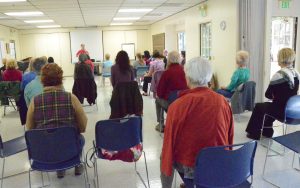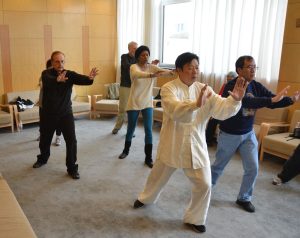What is Qigong?
Qigong is a Chinese body & mind exercise with more than five thousand years of history. Qigong consists of two words—Qi and gong. In Chinese cultural perspective, all things in the universe, visible and invisible, are the manifestation of Qi. In other words, Qi is the source or the matter that make up the universe. Qi is formless and invisible. The appearance or disappearance of matter is caused by the transmutation (concentration or dispersal) of Qi. Qi exists in and permeates everything. In the word “Qigong”, Qi means life energy—an invisible and formless substance that powers the functions of human life. Gong means practice. The 2 words together mean, “practicing Qi”.
The Definition of Qigong
Grandmaster Pang Ming gives the following definition of Qigong:
Qigong is a training that requires the participant to consciously use the mind intent to focus inward to transform, to improve, and to enhance life functions. Mental, posture, and breathing adjustments are the extensions of the inward training. It is a training which enables the participants to transform natural instinctive activities into conscious activities.
It points out Qigong’s unique training method—Mind Inward Focusing Training. This specific training has two implications.
The Difference Between Qigong and Physical Exercise
The difference between Qigong and physical exercise is based on whether the mind is inward focusing or not. With the exception of body/muscle building, the participant’s mind intent in all physical exercise is always outward focusing. Instead of focusing on one’s own physical body, in physical exercise the mind is always focused on the external object.
How does Qigong work?
![guolin_qigong[1]](https://www.chilelwellness.com/wp-content/uploads/2015/05/guolin_qigong1.jpg)
Medical Qigong, for instance, involves the concepts of concentration and dispersion of Qi. Practicing Medical Qigong strengthens this natural process. If this process functions normally, then the human body is operating at its optimum potential. The reason we have illness is that this process has been disrupted. For example, when qi is concentrated too much and is not being dispersed in a normal way, too much qi accumulates in an area, creating a tumor. If we can disperse the qi, then the tumor will disappear.
Misconceptions
As Qigong becomes popular, misconceptions are abundant. The 2 most common misconceptions are: Qigong takes years to learn and Qigong is superstition. In the last few years, many “masters” claim to have obtain true transmission from a divine source and are here to save the world. Many of them eventually fade away. In order to demonstrate that it neither required years to learn nor is superstition, some Qigong Masters established training and recovery centers.
What is Qigong?
Chilel Qigong
Taiji Neigong
Nei Yang Gong
His Holiness Dalai Lama teaches Breathing Qigong



